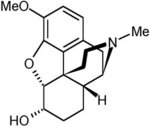Dihydrocodeine
Dihydrocodeine, also called DHC or DF-118, is a synthetic opioid analgesic prescribed for postoperative pain, severe dyspnea, or as an antitussive. It was developed in the early 1900s, and is similar in chemical structure and pharmaceutical behaviour to codeine, but is approximately twice as potent. It has approximately 30% the potency of IM morphine. more...
Although dihydrocodeine does have extremely active metabolites, in the form of dihydromorphine and dihydromorphine-6-glucuronide (100x more potent), these metabolites are produced in such small amount that they do not have clinically important effects2.
Indications
Approved indication for dihydrocodeine is the management of moderate to severe pain. It is usually formulated as tablets containing 30 mg with one tablet taken every 4-6 hours when necessary.
Dihydrocodeine is sometimes marketed in combination preparations with paracetamol (acetaminophen) as co-dydramol (BAN) to provide greater pain relief than either agent used singly (q.v. Drug Synergy).
Side Effects
As with other opioids, tolerance and physical and psychological dependence develop with repeated dihydrocodeine use. All opioids can impair the mental and/or physical abilities required for the performance of potentially hazardous tasks such as driving or operating machinery if taken in large doses, but have the opposite effect in moderate doses .
Regulation
In the USA, it is a DEA Schedule II substance, although preparations containing small amounts of dihydrocodeine are classified as Schedule III or Schedule V, depending on the concentration of dihydrocodeine relative to other active constituents, such as acetaminophen.
In the United Kingdom dihydrocodeine is a Class B drug - making it (in principle) more dangerous than cannabis which is a class C drug. Illegal possession of dihydrocodeine can result in up to 5 years in prison and/or an unlimited fine.
Read more at Wikipedia.org



